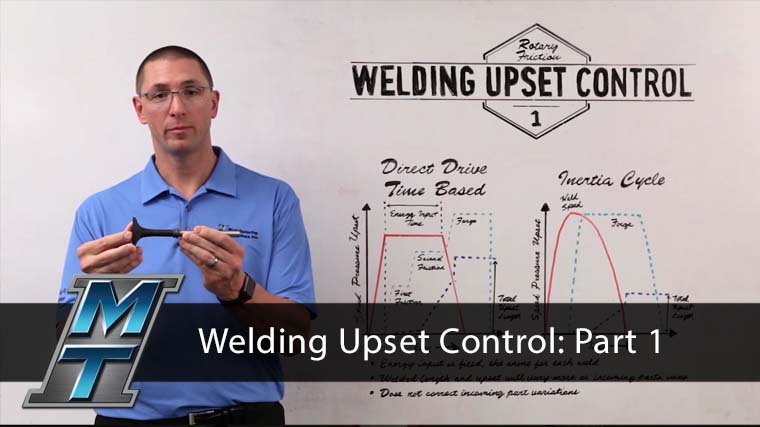
In previous Whiteboard Wednesday videos, we discussed the various types and benefits of rotary friction welding. The two most common types that have been discussed are Inertia and Direct Drive Friction. In this post, we’re going to look at an important aspect of these friction welding types: upset control.
What is upset control? In friction welding, the amount of upset you get as a result of welding is a measurement of how much shorter the two incoming parts become when the weld is complete. This should not be confused with overall length, which is a measurement of the length of the completed part.
Practical Application
Let’s see how that works in practice. If, for example, while friction welding with perfect incoming parts (yes, we know, you’ll rarely have perfect parts), the same amount of energy is imparted on every weld, you would get very consistent upset every time you weld the part.
But we work in the real world. Outside of this hypothetical, you will have many differences in surface area that could affect how the energy is converted. Factors including surface cleanliness, material differences such as heat treatment or hardness, or the part interface “squareness” could all affect how the energy is dissipated during welding, thereby affecting the amount of upset.
With all of these different factors at play, here is how upset control is affected by a fixed energy process in direct drive friction and inertia friction welding:
Direct Drive Friction Welding – Upset Control
Within direct drive friction welding, if the machine uses a time-based control system then there is a fixed amount of energy imparted (from the electric motor that is driving the spindle and rotating component). If the part is rotated for a specific amount of time at the same load conditions, then the same amount of energy is put into the part every time. With perfect parts, the amount of upset would be consistent.
Inertia Friction Welding – Upset Control
In inertia friction welding, there is a rotating flywheel mass. If the flywheel is rotated up to a certain speed then disengaged, the stored kinetic energy is consistent every time the weld is made. Again, with perfect parts the upset would be consistent.
Keep in mind that machine differences like pressure control, spindle temperature, machine efficiencies, or even interface alignment due to tooling misalignment may also affect upset, even when using a fixed energy process.
As you can see, if we rely solely on fixed energy to control upset, there is no correction for incoming part differences. It’s essentially an open-loop control and the physics of either process will dictate how repeatable the upset may be.
MTI Can Solve Your Problems
MTI will design machines based on your specific applications. We specialize in engineering new joining solutions based on where our customers want to go, and want you to understand our processes because we know that we can help get you there. We’ll build a machine that makes your part, we’ll make the part for you, or we’ll help you make the part even better. Contact us to start the process.
 MTI UK
MTI UK  FWT
FWT